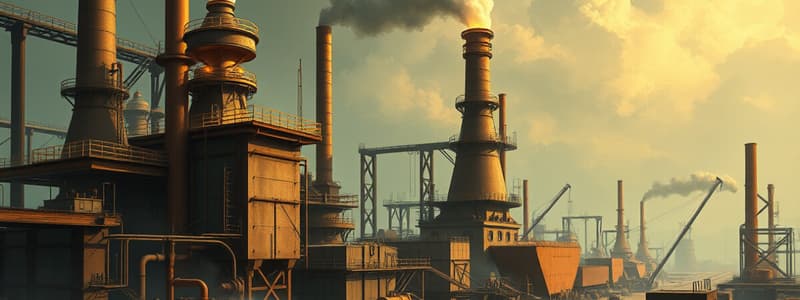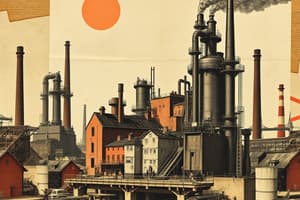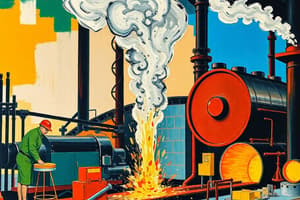Podcast
Questions and Answers
What was a key stipulation of the Chinese Exclusion Act?
What was a key stipulation of the Chinese Exclusion Act?
- It allowed Chinese migrants to become U.S. citizens without restrictions.
- It encouraged Chinese individuals to assimilate into American culture.
- It provided financial support for Chinese immigrants.
- It required Chinese persons to carry identification visas at all times. (correct)
What characterized the working conditions for many American workers during the Second Industrial Revolution?
What characterized the working conditions for many American workers during the Second Industrial Revolution?
- Child labor was completely eradicated.
- Workers enjoyed substantial benefits and high wages.
- Safety regulations were strictly enforced.
- There was a lack of paid holidays and a high accident rate. (correct)
Which of the following ideologies directly supported nativism during this period?
Which of the following ideologies directly supported nativism during this period?
- Progressivism
- Social Justice
- Liberalism
- Social Darwinism (correct)
What was one major consequence of the Spanish-American War for the United States?
What was one major consequence of the Spanish-American War for the United States?
What was one of the main impacts of the Bessemer steel process during the Second Industrial Revolution?
What was one of the main impacts of the Bessemer steel process during the Second Industrial Revolution?
Which social issue in urban areas was primarily addressed by muckrakers?
Which social issue in urban areas was primarily addressed by muckrakers?
Which strategy did corporations use to achieve market control during the Second Industrial Revolution?
Which strategy did corporations use to achieve market control during the Second Industrial Revolution?
What was a primary reason for the rise of nativism during the Gilded Age?
What was a primary reason for the rise of nativism during the Gilded Age?
What did the Granger movement primarily aim to address?
What did the Granger movement primarily aim to address?
What was one of the main prompts for labor unions to form during the Second Industrial Revolution?
What was one of the main prompts for labor unions to form during the Second Industrial Revolution?
What was one of the key goals of the Populist Party?
What was one of the key goals of the Populist Party?
Which journalist's work specifically led to the break-up of Standard Oil?
Which journalist's work specifically led to the break-up of Standard Oil?
Which factor was NOT a cause of World War I?
Which factor was NOT a cause of World War I?
What was one outcome of the United States entering World War I in 1917?
What was one outcome of the United States entering World War I in 1917?
What was a consequence of the Treaty of Versailles?
What was a consequence of the Treaty of Versailles?
What economic phenomenon characterized the 1920s in America?
What economic phenomenon characterized the 1920s in America?
Which president is often associated with the economic prosperity of the 1920s?
Which president is often associated with the economic prosperity of the 1920s?
What event marked the beginning of the women's rights movement in the United States?
What event marked the beginning of the women's rights movement in the United States?
What was one major cultural consequence of the Harlem Renaissance?
What was one major cultural consequence of the Harlem Renaissance?
Which factor contributed to the rise of the Ku Klux Klan in the 1920s?
Which factor contributed to the rise of the Ku Klux Klan in the 1920s?
How did credit influence consumer behavior in the 1920s?
How did credit influence consumer behavior in the 1920s?
What was a significant outcome of the Wall Street Crash of 1929?
What was a significant outcome of the Wall Street Crash of 1929?
What was the primary focus of women's clubs formed during the 18th and 19th centuries?
What was the primary focus of women's clubs formed during the 18th and 19th centuries?
What was the main social movement that influenced music and literature during the Harlem Renaissance?
What was the main social movement that influenced music and literature during the Harlem Renaissance?
What was one common misconception held by some early feminists regarding the Equal Rights Amendment?
What was one common misconception held by some early feminists regarding the Equal Rights Amendment?
Flashcards are hidden until you start studying
Study Notes
Second Industrial Revolution
- The era marked a significant transformation in U.S. industry, propelled by the Bessemer steel process.
- Scientific management aimed to enhance worker efficiency, often leading to dehumanization.
- Corporations sought competitive edges through pools, monopolies, horizontal and vertical integration with minimal government regulation.
- Sherman Antitrust Act was a key government attempt to curb anti-competitive practices.
Labor Dynamics and Social Issues
- Post-Civil War to WWI, a wave of unskilled labor opportunities arose, especially filled by immigrants, women, and children.
- Lack of minimum wage led American men to earn poverty wages for long workweeks without paid time off.
- Workplace safety was severely inadequate, exemplified by the Triangle Shirtwaist Factory fire in 1911.
- The rise of labor unions aimed to ameliorate working conditions and decrease child labor.
Nativism and Immigration
- Xenophobia surged during industrialization, particularly against Chinese and Eastern European immigrants.
- Nativism prioritized established inhabitants’ interests while restricting immigrant rights.
- Social Darwinism underpinned nativist ideologies, promoting the belief that some nations were superior.
- Key legislation included the Page Act of 1875 and the Chinese Exclusion Act, which placed restrictions on immigrants.
Urbanization
- Urbanization concentrated populations in cities during the late 1800s and early 1900s, largely due to rural-to-urban migration and immigration.
- Growing cities struggled with inadequate infrastructure, leading to squalid living conditions and disease outbreaks.
- Reform efforts by muckrakers and civic leaders initiated urban planning, improved sanitation, and expanded public services.
American Imperialism
- Imperialism evolved as the U.S. sought military and economic presence abroad post-Civil War, influenced by isolationism.
- Social Darwinism promoted the notion of superior nations exerting control over weaker ones.
- Territories acquired included Alaska, Hawaii, and others post-Spanish-American War, which concluded in 1898.
Spanish-American War
- The war spanned April to July 1898, driven by multiple factors including Cuban independence and Yellow Journalism.
- The U.S.S. Maine explosion incited public sentiment toward war.
- Resulting Treaty of Paris (1898) resulted in Cuba’s independence, U.S. acquisition of Puerto Rico, Guam, and the Philippines.
- The war established the U.S. as a global power while leading to subsequent conflict in the Philippines.
Farmers’ Struggles
- Farmers faced declining prices and unfavorable federal policies, organizing through the Granger movement and Farmers' Alliances.
- Government actions largely favored industrial interests, leading to the formation of the Populist Party advocating for free silver and economic reforms.
- The Populist movement's decline was precipitated by the 1896 election when Bryan co-opted their platform.
Progressivism
- Progressivism emerged to address societal issues through reform, with leaders like Bryan and La Follette advocating for change.
- Key social issues included child labor and women’s rights, culminating in women's suffrage.
- African Americans, however, saw little advancement during this era despite broader societal reforms.
Muckrakers and Reform
- Muckrakers exposed government corruption and corporate malpractices, prompting public outcry and reforms.
- Influential works like Tarbell's expose and Sinclair's "The Jungle" led to significant food safety legislation.
- By 1912, muckraking as a movement began to wane, although its impact persisted.
Causes of World War I
- Core causes included military alliances (Triple Alliance vs. Triple Entente), nationalism, militarism, and imperialism.
- The assassination of Archduke Ferdinand in 1914 triggered widespread conflict in Europe.
- Despite initial neutrality, U.S. involvement was catalyzed by submarine warfare, propaganda, and the Zimmerman Telegram.
Aftermath of World War I
- U.S. entry shifted the balance, leading to an Allied victory and the signing of the Treaty of Versailles in 1919.
- The treaty emphasized punitive measures against Germany and established the League of Nations, which the U.S. did not join.
Economic Boom of the 1920s
- The Roaring Twenties were characterized by technological advancements, expanding consumer culture, and widespread debt.
- Credit became prevalent, and the economy thrived until the Wall Street Crash of 1929 ended the decade's prosperity.
Political Landscape of the 1920s
- The post-WWI era saw a shift away from progressivism towards a conservative political climate.
- Warren G. Harding's presidency promised a return to normalcy but was marred by scandals, notably the Teapot Dome Scandal.
- Coolidge's administration embraced pro-business policies until the stock market crash led to economic downturn.
Women's Rights Movement
- Women sought to break the "separate spheres" ideology, leading to the formation of clubs that advocated for social reforms.
- The Seneca Falls Convention in 1848 marked a significant moment in the women's rights movement with the Declaration of Sentiments.
- The 19th Amendment, ratified in 1920, granted women the right to vote.
Harlem Renaissance
- The Harlem Renaissance celebrated African American culture through art, music, and literature.
- Influential figures included artists like Aaron Douglas and literary figures like Langston Hughes, who blended jazz and poetry.
Rise of the Ku Klux Klan
- The Klan re-emerged in the 1920s fueled by nativism and eugenics, aiming to protect white supremacy.
- They leveraged societal fears about immigration, utilizing violence and terror to uphold white American traditions.### The First Red Scare
- Originated after World War I and the Bolshevik Revolution, fueled by fears of communism, labor unrest, and xenophobia.
- Reached its peak with the Palmer Raids (1919-1920), targeting suspected radicals and communists across the U.S.
- Public backlash against the brutality of the Palmer Raids led to a decline in the scare's intensity.
- The fear of communism resurfaced during the Cold War and contributed to the Second Red Scare.
The Wall Street Crash of 1929
- Triggered by over-speculation in the stock market; marked the onset of the Great Depression.
- The Roaring Twenties saw an investment boom, with many borrowing money to buy stocks.
- The market peaked in summer 1929, collapsing in October after eight years of unprecedented growth.
- Federal negligence and bank investments in stocks led to economic downturn.
- Federal intervention in 1933 helped restore confidence and initiated the first growth in the stock market during the Depression.
The Great Depression
- Characterized by an unemployment rate peaking at 25%.
- Unemployed individuals faced severe hardship, resorting to soup lines and shantytowns.
- The Dust Bowl devastated rural farming communities, particularly in the Midwest.
- Labor strife intensified, with protests and strikes increasing in the manufacturing sector.
- Minority groups, especially sharecroppers and Latino communities, faced discrimination and hardship.
- African Americans faced job loss and systemic violence, with barriers to voting imposed.
Franklin D. Roosevelt and the New Deal
- Elected in 1932, Roosevelt's New Deal aimed to provide relief, recovery, and reform during the Great Depression.
- Relief programs included unemployment aid, Social Security for the elderly, and the Works Progress Administration (WPA).
- Recovery efforts involved fair labor practices and boosting prices through the Blue Eagle campaign.
- Reforms included bank deposit insurance and the establishment of the U.S. Securities and Exchange Commission.
- The New Deal is considered a pivotal response to the economic crisis but had limitations, particularly for minorities.
Roosevelt's Second New Deal
- Occurred from 1935 to 1937; marked a shift in approach with key legislation like the Social Security Act.
- Faced political challenges including an ill-fated court-packing plan to secure support for New Deal legislation.
- Despite setbacks, some New Deal programs retained constitutional support through Supreme Court decisions.
- Economic stagnation persisted post-1937, with full recovery only achieved during World War II.
Impact of the New Deal
- Expanded the federal government’s role in the economy; created agencies like the WPA and CCC.
- Infrastructure projects included the construction of the Hoover Dam and Tennessee Valley Authority.
- The New Deal remains a benchmark for evaluating social programs, inspiring future initiatives like the Green New Deal.
- Critiques center around its inadequacies in regulating corporate power and addressing minority concerns.
Shift in Foreign Policy
- Roosevelt transitioned U.S. policy from isolationism to interventionism, beginning with the Good Neighbor Policy.
- Neutrality Acts imposed restrictions on arms sales and trade with wartime nations, limiting Roosevelt's options.
- As international tensions rose, he engaged in 'cash-and-carry' trade and struck deals for military aid to Allies.
- U.S. entry into WWII was catalyzed by the Japanese attack on Pearl Harbor on December 7, 1941.
World War II Overview
- Initiated with Germany's invasion of Poland in 1939; widely recognized as a global conflict.
- Caused by failures of the League of Nations, unresolved issues from World War I, and aggressive expansion by Axis Powers.
- The Holocaust resulted in significant civilian casualties, with Nazi leaders later tried for war crimes.
- Post-war shifts led to the creation of new nations and ideological divides setting the stage for the Cold War.
Pearl Harbor Attack
- The Japanese surprise attack on Pearl Harbor on December 7, 1941, resulted in significant U.S. naval losses.
- Prompted the U.S. Congress to declare war on Japan, leading to subsequent declarations against Germany and Italy.
Life on the Home Front
- The war effort heavily mobilized American civilians, with many contributing in various ways.
- Executive Order 9066 led to the internment of over 75,000 Japanese Americans in isolation camps.
- Rationing became a norm, altering daily life and consumer practices across the nation.
- The war contributed to an economic boom in the U.S. as production ramped up for military needs.
Studying That Suits You
Use AI to generate personalized quizzes and flashcards to suit your learning preferences.




